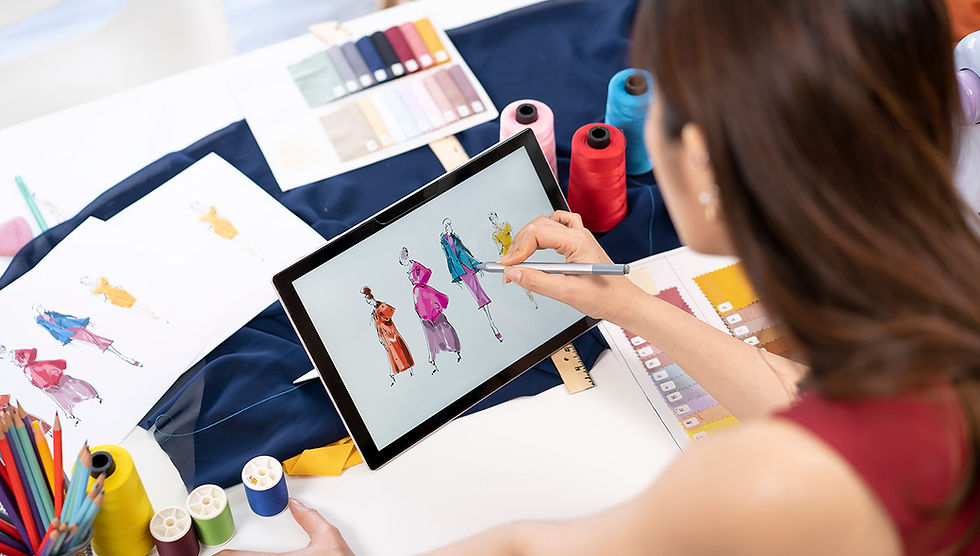INSIDE THE FASHION INDUSTRY - Why Size Inclusivity Matters & How Brands Are Building the Future
- Barbara Sessim

- Oct 13
- 4 min read

Fashion today is no longer just about trends; it’s about relevance. Brands that treat sizing as an afterthought risk alienating large swathes of consumers, losing revenue to competitors that get fit and representation right, and damaging long-term loyalty. Conversely, brands that take sizing seriously are finding not only cultural goodwill but measurable business upside. Below I walk through why inclusive sizing matters, the operational obstacles brands must solve, how several companies have turned inclusivity into growth, and what the future of ready-to-wear looks like.
Consumers want fit and representation
A growing body of consumer research shows that inconsistent sizing and poor fit are among the top reasons people abandon purchases or return goods — a problem that hits mid-size and plus-size shoppers hardest. Shoppers report frustration with brand-dependent sizing, poor representation in marketing, and garments that don’t account for diverse body proportions; many say they would pay more for better fit and quality. These dynamics make inclusive sizing not just an ethical choice but a conversion and retention strategy for direct-to-consumer and retail brands alike. Vogue Business
Sizing gaps are structural - and solvable
The common barriers to broadening size ranges are familiar: higher sampling and grading costs, minimum order quantities that punish low-volume extended sizes, unstandardized grading rules that don’t translate shape proportions, and retail/buyer assumptions about demand. Brands that succeed don’t ignore these challenges — they redesign processes (fit labs, extended sampling), rework grading and tech packs, and invest in representation so larger assortments get supported by marketing and sales. Vogue Business
Case studies - inclusivity that paid off
Universal Standard built its identity on offering sizes 00–40 and testing each garment across its full range. Their “Fit Liberty” program - allowing customers to exchange sizes as their bodies change - has turned inclusivity into long-term trust. Vogue+1
Savage X Fenty, founded by Rihanna, made inclusivity a core principle from day one. With diverse casting and lingerie sizes ranging from 32A to 46DDD and XS to 4X, the brand reshaped beauty standards while achieving massive commercial success. Forbes+1
Eloquii and Torrid, both dedicated to plus-size markets, proved that consistent demand exists far beyond “specialty” segments. Torrid’s IPO and Eloquii’s acquisition by Walmart underline that this audience is both loyal and profitable. The Business of Fashion+1
Practical wins brands are using now
• Product engineering: Fit-testing across size spans and adjusting patterns for proportional shape differences rather than simple grade rules. Vogue Business
• Operational levers: Smaller MOQs through flexible factories, made-to-order capsules for low-volume sizes, and smart inventory allocation so extended sizes are stocked where demand exists. Vogue Business
• Customer experience: Size guides that go beyond a flat chart (fit videos, measurements, AR/3D try-ons), generous exchange/return policies, and marketing that shows diverse bodies in real contexts. Universal Standard’s exchange initiatives are an example of marrying customer policy to sizing realities. Vogue Business+1
The business case - brand health and unit economics
Inclusive assortments can reduce returns (by improving initial fit), expand the addressable market, and build stronger repeat purchase behavior. The path to profitability often requires short-term investment (sampling, marketing, tech) and longer timelines for assortment optimization — but for many brands the incremental revenue and improved brand equity make inclusivity a durable competitive advantage. Torrid’s and Savage X Fenty’s trajectories show how addressing underserved size segments can scale into mainstream commercial success. The Business of Fashion+1
Where ready-to-wear is heading: practical and technological shifts
Expect a convergence of better grading systems, AI-driven fit recommendations, and modular garments that adapt across sizes (adjustable closures, stretch-engineered panels). Retailers will increasingly use data to place extended sizes in the right stores and to reduce deadstock risk. Designers who embed inclusivity into product DNA - not as a seasonal add-on - will be better positioned to convert social momentum into consistent sales. Recent industry reports show modest runway progress but make clear that tokenism won’t cut it: structural change across design, production and retail is required. Vogue Business+1
A realistic roadmap for a ready-to-wear label
Start by perfecting 3–5 core silhouettes across an initial broad size range (fit every size); use those as your conversion drivers.
Rebalance sampling budgets to include extended sizes early in development.
Partner with factories willing to run mixed-size batches or lower MOQs for strategic SKUs.
Publish transparent size and fit information; invest in a generous and easy exchange flow.
Use marketing and editorial to normalize the assortment and avoid treating larger sizes as an afterthought. (This is where brands like Savage X Fenty and Universal Standard turned values into loyalty.) Forbes+1
Size inclusivity is not a trend to be opportunistically mined - it’s a market reality and a design imperative. Brands that invest in fit, make operational shifts to support extended assortments, and represent diverse bodies consistently will convert cultural leadership into economic value. The proof is already visible: specialty plus brands scaling strongly, major DTC players proving that inclusivity fuels growth, and industry research documenting unmet consumer demand. For ready-to-wear labels facing tight margins and fickle attention, inclusive sizing is one of the clearest routes to differentiated, lasting relevance. Vogue Business+1
If you’re building your own ready-to-wear brand, now is the time to think beyond trend and start designing for inclusion. Size diversity isn’t just good ethics - it’s good business! I help emerging designers develop strategies that make their collections both marketable and meaningful - from defining your target audience to creating production-ready, size-inclusive pieces.
Book your free 30-minute strategy call through the link below, and let’s make your brand part of the future of fashion.







Comments